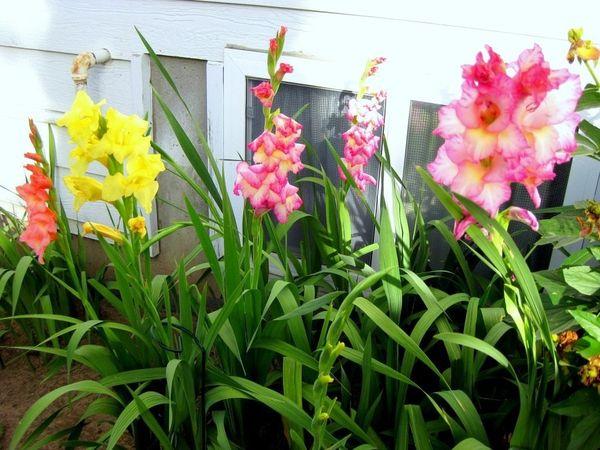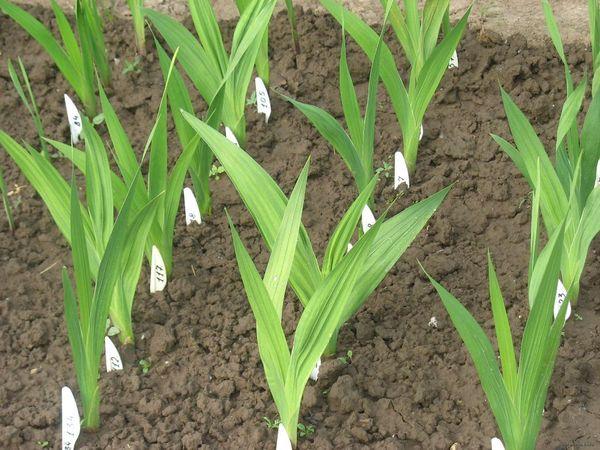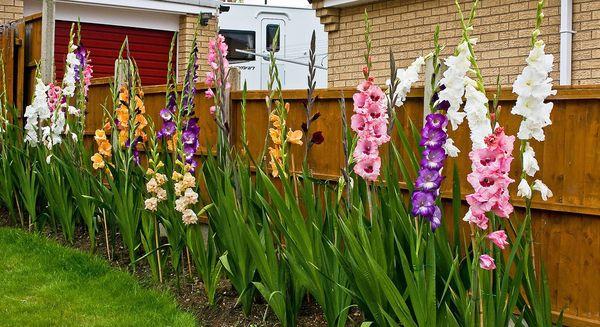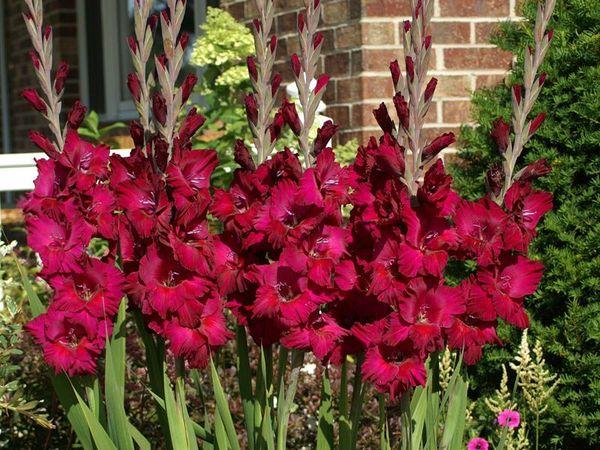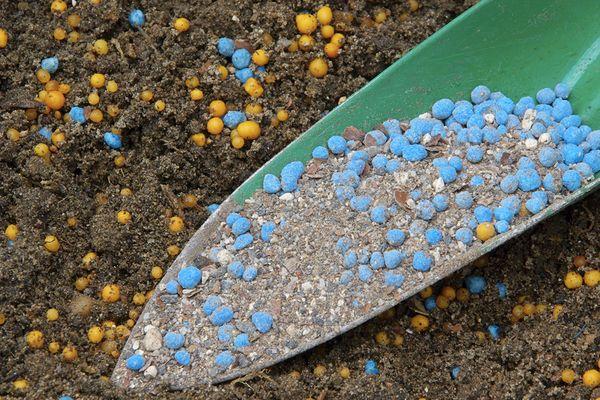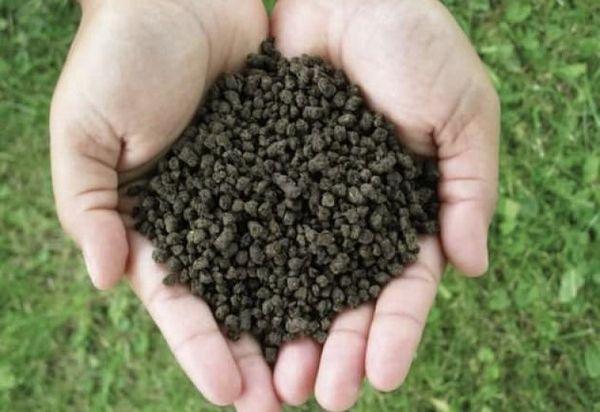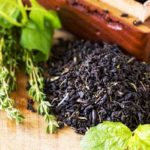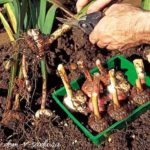Gladioli have earned the title of one of the most beautiful plants in the garden. Selectors have been breeding this variety for many years. Previously, the plants had small, loose flowers, and the stems were weak and sluggish. Numerous experiments resulted in strong stems, ruffled petals and large flowers. Feeding gladioli flowers in summer and spring will help to achieve lush flowering.
Necessary fertilizers for gladioli
Feeding is the key to the successful growth of any plant. Gladioli are very sensitive to moisture and do not tolerate heat well.They need systemic watering and constant fertilization with nutrients.
Feeding gladioli should occur according to a specific scheme. It should coincide with the stages of flower development.
It is necessary to prepare the soil for planting in the fall. Fertility increases when fertilized with manure diluted with water. When choosing mineral fertilizers, you should give preference to simple phosphorus and potassium fertilizers.
The flower emerges 13-19 days after planting. Having noticed the first grown shoots, you need to mulch the ground with humus. As a replacement, you can use peat, straw, chopped bark, pine needles or grass. Thanks to these manipulations, the soil does not dry out, aeration improves, and weed germination is reduced.
in spring
The first replenishment of the gladiolus occurs during planting. It will ensure active growth of shoots, form high-quality leaf mass and lay flower stalks. At the first stage, nitrogen is important for gladioli. You can “feed” the flower with nitrogen fertilizers or complete mineral mixtures with low potassium levels.
First feeding
In spring, it is customary to fertilize the plant:
- urea (25-30 g);
- ammonium nitrate (35-40 g);
- potassium sulfate (20 g);
- wood ash (45-50 g);
- simple superphosphate (35 g).
The specified amount of the mixture must be dissolved in 10 liters of water. The mineral solution is replaced with mullein, chicken manure with superphosphate and potassium permanganate. Having planted the plant in late spring, it is better to postpone the time of nitrogen fertilizing until the 4th leaf appears. After the 6th leaf appears, the leaves stop consuming nitrogen and need more phosphorus.
Second feeding
It is necessary to fertilize the plant a second time with a combined solution with such elements as:
- phosphorus-potassium mixture;
- nitrogen-potassium substances;
- phosphate fertilizers.
You can get powerful peduncles and large flowers using foliar feeding with microfertilizers. The corms will be large if you feed them with a boron solution. To make it, take boric acid (2-3 g) and water (10 l).
In summer
Young gladioli at the beginning of summer need substances that improve the formation of the root system. Stable growth in the absence of moisture is ensured by water-soluble calcium. Plants absorb this element well, which contains calcium nitrate.
Third make-up
At this stage, potassium phosphate mixtures will be required, especially urea (15-20 g) and potassium sulfate (25-30 g). Ash is especially useful when planting. It contains more than 30 nutrients that ensure abundant flowering of gladioli.
Ash is used for feeding at the beginning of summer, with the appearance of the first shoots. The solution is prepared using water (10 l) and ash (1 l). The mixture is infused for 24 hours, after which you can water the plant.
Next, the gladiolus is recharged according to the following scheme:
- during the period of peduncle formation and flowering, nitrophoska (25-30 g) dissolved in water (10 l) is used;
- when the plant has bloomed, it should be fertilized with superphosphate (15-20 g) and potassium sulfate (25-30 g);
- feeding is done using a superphosphate extract. To prepare it you will need superphosphate (200-250 g) and hot water (1-1.5 l).
At the beginning of September, disinfection and feeding with a potassium solution are done: potassium permanganate (5 g), water (10 l). Further, the plant does not need feeding. Fertilizer mixtures must be liquid. Powders are not as effective as solutions.
The best fertilizer for lush flowering
Phosphorus fertilizers affect the release of peduncles and the number of buds. Without this element there will be no hydrocarbon metabolism, and without its absence the number of buds and flowering decreases.
Additional stimulation of the rapid development of gladiolus and abundant flowering in mid-summer is possible. In addition to potassium and wood ash, banana peels can be called a source of useful elements. It contains a lot of potassium, which will accelerate the growth of the flower.
The skin must be dried and crushed. Before planting a flower, you need to sprinkle the ground with the prepared mixture. The decomposition of the mixture will provoke active production of potassium. With this solution you can achieve lush flowering and eliminate aphids.
We prepare our own fertilizer compositions
Independent preparation of compositions takes place according to the following rules.
- To form buds and enhance the brightness of flowers, you will need urea (15 g), potassium sulfate (15-20 g), superphosphate (25-30 g), water (10 l). Mix all ingredients thoroughly with water and pass the solution between rows.
- You can fertilize flowers using complex fertilizers containing microelements. Before the plant begins to bloom, it needs to be fed with superphosphate (25-30 g), potassium sulfate (20-25 g). Mix the ingredients together, add 10 liters of water and water the beds.
- You can feed with mullein, horse manure and bird droppings. All elements are mixed with water (10 l) and infused for 4-5 days.
A solution of manure (1 liter) can be dissolved in a bucket of water and watered in the beds between the rows.
How to apply fertilizer correctly
The soil should be watered before and after fertilizing. The soil must be weeded and loosened before fertilizing. A nutrient solution is used for watering between rows.After fertilizing the plants, they need to be filled with plenty of water.
Gladiolus flowers should be fed in the evening so that the mixture does not evaporate too quickly and is well absorbed into the roots.
In rainy weather, you should not water gladioli with the solution; the rain will wash it away anyway.
Feeding frequency
The frequency of feeding can be determined by the growth stage of the gladiolus. Their planting usually occurs in late spring, so their development is greatly influenced by weather conditions. The growth of gladioli occurs in the following stages:
- the first pair of leaves appears;
- 6-7 leaves are formed;
- flower stalks are formed;
- buds bloom.
You can fertilize the plant between stages of development. In this case, the condition of the plant must be taken into account. In case of deficiency of a particular nutrient, it can be applied either as an independent fertilizer or in combination with other microelements.

